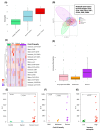The FLARE Score and Circulating Neutrophils in Patients with Cancer and COVID-19 Disease
- PMID: 39272832
- PMCID: PMC11393969
- DOI: 10.3390/cancers16172974
The FLARE Score and Circulating Neutrophils in Patients with Cancer and COVID-19 Disease
Abstract
Purpose: Inflammation and neutrophils play a central role in both COVID-19 disease and cancer. We aimed to assess the impact of pre-existing tumor-related inflammation on COVID-19 outcomes in patients with cancer and to elucidate the role of circulating neutrophil subpopulations.
Methods: We conducted a multicenter retrospective analysis of 524 patients with cancer and SARS-CoV-2 infection, assessing the relationship between clinical outcomes and circulating inflammatory biomarkers collected before and during COVID-19 infection. Additionally, a single-center prospective cohort study provided data for an exploratory analysis, assessing the immunophenotype of circulating neutrophils and inflammatory cytokines. The primary endpoints were 30-day mortality and the severity of COVID-19 disease.
Results: Prior to COVID-19, 25% of patients with cancer exhibited elevated dNLR, which increased to 55% at the time of COVID-19 diagnosis. We developed the FLARE score, incorporating both tumor- and infection-induced inflammation, which categorized patients into four prognostic groups. The poor prognostic group had a 30-day mortality rate of 68%, significantly higher than the 23% in the favorable group (p < 0.0001). This score proved to be an independent predictor of early mortality. This prospective analysis revealed a shift towards immature forms of neutrophils and higher IL-6 levels in patients with cancer and severe COVID-19 infection.
Conclusions: A pre-existing tumor-induced pro-inflammatory state significantly impacts COVID-19 outcomes in patients with cancer. The FLARE score, derived from circulating inflammatory markers, emerges as an easy-to-use, globally accessible, effective tool for clinicians to identify patients with cancer at heightened risk of severe COVID-19 complications and early mortality who might benefit most from immediate and intensive treatment strategies. Furthermore, our findings underscore the significance of immature neutrophils in the progression of COVID-19 in patients with cancer, advocating for further investigation into how these cells contribute to both cancer and COVID-19 disease.
Keywords: COVID-19; IL-6; cancer; dNLR; neutrophils.
Conflict of interest statement
E.S. declares personal fees for educational events and/or material from Novartis, Pfizer, Eisai, and Daiichi Sankyo; advisory fees from Pfizer and Seagen; and travel/accommodation expenses from Gilead, Daiichi Sankyo, Novartis, and Lilly. M.G.H reports personal fees (invited speaker) from Ipsen and travel/accommodation expenses from Novartis. T.G declares personal fees (invited speaker) from GSK and travel/accommodation expenses from Bristol Myers Squibb, Reddy’s, Pfizer, and MSD. J.G declares personal fees (invited speaker) from LEO Pharma and Astellas Pharma, and travel/accommodation expenses from Lilly, Bristol Myers Squibb/Roche, Ipsen, Novartis, and Roche. J.C.T reports travel/accommodation expenses from: Merck, Pfizer, Roche, and Lily/Genentech. M.T declares travel/accommodation expenses from ElI−Lilly. C.T declares no competing non-financial interests but reports advisory and consulting fees from Novartis and AstraZeneca, lecture fees from Roche, Pfizer, Biocartis, MSD, and Janssen Oncology, and research fees from Novartis. H.A declares consulting fees from AstraZeneca, lecture fees from Takeda, and travel/accommodation expenses from Angelini Pharma, BMS, MSD, Roche, and Takeda. S.P reports personal fees (invited speaker, advisory board) from AstraZeneca, ElI−Lilly, Novartis, AMGEN, Takeda, Sanofi, Bristol Myers Squibb, MSD, and Roche, and research grants from AstraZeneca, Bristol Myers Squibb, and Roche outside the submitted work. X.M.-R. declares research grants from Bristol Myers Squibb; fees for educational activities from Novartis, Bristol Myers Squibb, AstraZeneca, Roche, Pfizer, MSD, Takeda, Ferrer, and Esteve; advisory fees from Takeda, Pfizer, MSD, Boehringer, and AstraZeneca; travel/accommodation expenses from Lilly, Boehringer, Roche, and Bristol Myers Squibb. F.B-M. has filed the HER2DX patent (PCT/EP2022/086493), the DNADX patent (EP22382387.3), and the TNBCDX patent (EP23382703.9). A.P. reports advisory and consulting fees from Roche, DaiichI−Sankyo, AstraZeneca, Pfizer, Novartis, Guardant Health, and Peptomyc; lecture fees from Roche, Novartis, AstraZeneca, and Daiichi Sankyo; institutional financial interests from Boehringer, Novartis, Roche, AstraZeneca, DaiichI−Sankyo, MedSIR, SL, Celgene, Astellas, and Pfizer; stockholder and consultant fees from Reveal Genomics, SL; the filing of the patent PCT/EP2016/080056, the HER2DX patent (PCT/EP2022/086493), the DNADX patent (EP22382387.3), and the TNBCDX patent (EP23382703.9). L.M. declares research grants from Amgen, Inivata, AstraZeneca, and Gilead; fees for educational activities from Bristol Myers Squibb, AstraZeneca, Roche, Takeda, Janssen, Pfizer, MSD, DaiichI−Sankyo, and Radonova; advisory fees from Roche, Takeda, AstraZeneca, Jannsen, and MSD; and travel/accommodation expenses from Bristol Myers Squibb, Roche, Takeda, AstraZeneca, and Janssen. The other authors declare no conflicts of interest.
Figures




References
-
- Pinato D.J., Zambelli A., Aguilar-Company J., Bower M., Sng C., Salazar R., Bertuzzi A., Brunet J., Mesia R., Segui E., et al. Clinical portrait of the SARS-CoV-2 epidemic in European cancer patients. Cancer Discov. 2020;10:1465–1474. doi: 10.1158/2159-8290.CD-20-0773. - DOI - PMC - PubMed
-
- Pinato D.J., Lee A.J.X., Biello F., Seguí E., Aguilar-Company J., Carbó A., Bruna R., Bower M., Rizzo G., Benafif S., et al. Presenting features and early mortality from SARS-CoV-2 infection in cancer patients during the initial stage of the COVID-19 pandemic in Europe. Cancers. 2020;12:1841. doi: 10.3390/cancers12071841. - DOI - PMC - PubMed
-
- Kuderer N.M., Choueiri T.K., Shah D.P., Shyr Y., Rubinstein S.M., Rivera D.R., Shete S., Hsu C.Y., Desai A., de Lima Lopes G., Jr., et al. COVID-19 and Cancer Consortium. Clinical impact of COVID-19 on patients with cancer (CCC19): A cohort study. Lancet. 2020;395:1907–1918. doi: 10.1016/S0140-6736(20)31187-9. - DOI - PMC - PubMed
-
- Meizlish M.L., Pine A.B., Bishai J.D., Goshua G., Nadelmann E.R., Simonov M., Chang C.H., Zhang H., Shallow M., Bahel P., et al. A neutrophil activation signature predicts critical illness and mortality in COVID-19. Blood Adv. 2021;5:1164–1177. doi: 10.1182/bloodadvances.2020003568. - DOI - PMC - PubMed
Grants and funding
LinkOut - more resources
Full Text Sources
Medical
Miscellaneous

